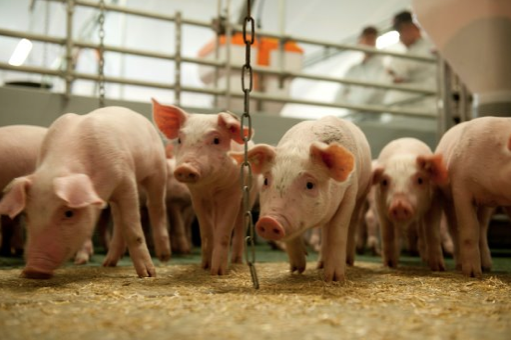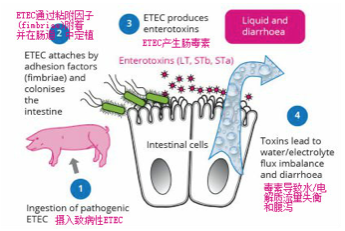Most pig farms take preventive measures to limit the economic impact of post-weaning diarrhoea, including safe feed formulations, addition of zinc oxide, use of antibiotics and feed additives. An active prevention through oral vaccination has recently been added to these range of preventive options.
大多数养猪场采取预防措施来限制断奶后腹泻的经济影响,包括安全的饲料配方、添加氧化锌、使用抗生素和饲料添加剂。最近,通过口服疫苗接种进行积极预防已加入到这些预防选择的范畴。
Post-weaning diarrhoea is an important intestinal disease that occurs in the first week after weaning, from days 3-7 post-weaning. The disease is characterised by dehydration, weight loss and death. This form of disease is responsible for economic losses due to death, runt piglets, decreased growth, increased variation in pig sizes within the pen, and increased use, thus increased costs, of medicines. On some pig farms the episode of diarrhoea may be postponed until shortly after the end of zinc oxide supplementation, commonly occurring around 14 days post-weaning.
断奶后腹泻是一种重要的肠道疾病,发生在断奶后第一周,即断奶后第3-7天。该病的特点是脱水、体重减轻和死亡。这种疾病造成的经济损失是由于死亡、小猪仔、生长速度下降、猪圈内猪的大小不均匀加剧以及药物使用增加而导致的成本上升。在一些养猪场,腹泻的发作可能推迟到中断补充氧化锌后不久,通常发生在断奶后14天左右。

Overall, better performance is seen in piglets vaccinated against E. coli.
总体而言,接种了大肠杆菌疫苗的仔猪生长性能更佳。
What is the cause of the disease?
大肠杆菌腹泻的由来
E. coli is the most important pathogen detected as the cause of post-weaning diarrhoea in piglets worldwide. The most important virulence factors are the adhesion factors followed by the enterotoxins. Adhesion factors allow the E. colibacteria to attach to the intestinal wall, notably through F4 (K88) and F18 adhesion sites. The enterotoxins produced provoke the occurrence of diarrhoea due to disturbance of the electrolyte balance at the level of the intestinal wall. Based on both groups of virulence factors, E. coli associated with post-weaning diarrhoea is also identified as enterotoxigenic E. coli (ETEC). The pathogenesis of post-weaning diarrhoea is schematically shown in Figure 1.
全球范围内,大肠杆菌是引起仔猪断奶后腹泻的最重要病原体。最重要的毒力因子是黏附因子,其次是肠毒素。黏附因子可使大肠杆菌附着于肠壁,特别是通过F4 (K88)和F18黏附位点。由于肠壁电解质平衡紊乱,所产生的肠毒素可引起腹泻。根据这两组毒力因子,与断奶后腹泻相关的大肠杆菌也被确定为产肠毒素大肠杆菌(ETEC)。断奶后腹泻的发病机制如图1所示。
Figure 1 – Pathogenesis of enterotoxigenic E. coli (ETEC) at the level of the small intestine.
图1 -肠毒素大肠杆菌(ETEC)在小肠的发病机制

A worldwide increase in the occurrence of post-weaning diarrhoea due F4- and F18-ETEC has been reported. A recent study over a 3-year period (2014-2016) on 504 farms in Belgium and the Netherlands has demonstrated that E. coli was the cause of post-weaning diarrhoea in 83.3% of the examined cases, of which were 45.8% F4-ETEC and 37.5% F18-ETEC.
据报道,世界范围内F4-和F18-ETEC引起的断奶后腹泻发生率有所增加。近期在比利时和荷兰的504个农场进行的一项为期3年(2014-2016)的研究表明,在调查的病例中,大肠杆菌是导致断奶后腹泻的原因,占83.3%,其中,F4-ETEC占45.8%,F18-ETEC占37.5%。
Important for farms
对猪场意义重大
Diseased animals are characterised by pronounced symptoms of fluid faeces (diarrhoea), weight loss, decreased appetite and slower growth, finally resulting in increased size variation of the piglets. The use of current preventive and curative alternatives support the piglets resulting in fewer symptoms of post-weaning diarrhoea.
患病动物的特征是有明显的水样粪便(腹泻)症状、体重减轻、食欲下降和生长缓慢,最终导致仔猪体型变化加大。使用现有的预防和治疗替代方法,可减少断奶后腹泻的症状。
However, this approach does not always lead to optimal technical performance. Adaptations in feeding strategy using a safe concept – mostly associated with a reduction in crude protein level or energy – results in growth reduction. Addition of zinc oxide provides a temporary protection against growth of E. coli in the intestine, although recent field studies with different feed concepts have demonstrated that optimum growth performance was not achieved using this specific approach.
然而,这种方法无法一直得到最佳性能。打安全牌调整喂养策略——主要与降低粗蛋白水平或能量有关——会导致生长减少。添加氧化锌可以暂时防止大肠杆菌在肠道内的生长,尽管最近针对不同饲料概念的实地研究表明,使用这种特定方法无法获得最佳的生长性能。
How to diagnose the disease?
如何诊断大肠杆菌腹泻?
The diagnosis of post-weaning diarrhoea can be performed through a combination of typical clinical signs (fluid faeces, runt-piglets, mortality) in relation to the time of the problem relative to weaning. That clinical diagnosis can be confirmed through necropsy and subsequent bacteriological examination. The virulence factors can be detected using a laboratory based PCR-technique.
断奶后腹泻可以结合与断奶时间相关的典型临床症状(液体粪便、小猪仔、死亡率)来诊断。临床诊断可通过尸检及随后的细菌学检查予以证实。利用PCR技术可以检测出病毒的毒力因子。
Figure 2 - Mode of action of the oral vaccination against post-weaning diarrhoea, with reduced clinical signs of diarrhoea and a reduction in faecal E. coli excretion in vaccinated piglets.
图2 -口服疫苗预防断奶后腹泻的作用机制,减少腹泻的临床症状,并减少接种后仔猪的粪便大肠杆菌排泄。

Challenges in the near future
不久的将来面临的挑战
Effective preventive measures against this disease are very diverse and remain a challenge for both pig farmers and their advisors. A diverse mix of potential interventions are available through adaptation of feed or addition of specific feed supplements (organic acids, probiotics, prebiotics, etc). Curative treatment with oral antibiotics (through feed or drinking water application) is another frequently used option.
针对这种疾病的有效预防措施是多种多样的,对养猪户及其顾问来说仍然是一个挑战。通过调整饲料或添加特定的饲料添加剂(有机酸、益生菌、益生元等),可以采取多种可能的干预措施。另一种常用的治疗方法是口服抗生素(添加在饲料或饮用水中)。
However, the pig world is now encouraged to develop alternatives such as individual treatment through targeted antibiotic injection or herd vaccination to protect against post-weaning diarrhoea. The increasing issue of antibiotic resistance, and the related pressure to decrease their use, suggests that the currently used practices are unacceptable as a long term solution. Zinc oxide is currently still a popular alternative to control colibacillosis in many European countries, although piglets do not perform to their maximum potential using zinc oxide.
然而,现在鼓励养猪界开发替代方案,例如通过有针对性的抗生素注射进行个体化治疗,或进行群体接种,以预防断奶后腹泻。越来越多的抗生素耐药性问题以及减少抗生素使用的相关压力表明,目前使用的做法无法作为长期解决办法。尽管使用氧化锌后,仔猪无法发挥最大生长潜力,目前在许多欧洲国家,氧化锌仍然是控制大肠杆菌病的一种流行的替代方法。
Oral vaccination against post-weaning diarrhea
预防断奶后腹泻的口服疫苗
The live apathogenic E. coli vaccine*, containing 2 different strains of E. coli, namely F4 and F18, can provide local protection through the stimulation of local antibodies in the small intestine. The vaccine is administered using waterbowls with electrolyte solution including the vaccine, or by individual drenching at least 7 to 8 days before the onset of clinical problems of post-weaning diarrhoea.
含有两种不同大肠杆菌菌株F4和F18的大肠杆菌灭活疫苗*,通过刺激小肠内的局部抗体,可以提供局部保护。疫苗使用方法有包括疫苗在内的含有电解质溶液的水碗,或在临床出现断奶后腹泻前至少7至8天进行单独淋洗。
Following intake, the live apathogenic E. coli bacteria attach to the intestinal cells and proliferate, thus stimulating local immunity – more specifically the production of immunoglobulin A (IgA) which is secreted into the intestinal lumen – providing the vaccinated animals with local protection.
摄入后,活的无菌性大肠杆菌附着在肠道细胞上并增殖,从而刺激局部免疫——更具体地说,是分泌到肠道腔内的免疫球蛋白A (IgA)的产生——为接种疫苗的动物提供局部保护。
Within 7 days after vaccination, local protection against subsequent challenge with pathogenic E. coli bacteria during the early post-weaning period is present within vaccinated piglets. The IgA antibodies attach to the fimbriae F4 or F18 from the ingested E. coli bacteria and prevent these pathogenic bacteria from attaching to the intestinal cells and any subsequent proliferation. Preventing this attachment and proliferation causes a reduction in severity of clinical signs, as observed by an improved faecal clinical score and a reduction in the faecal excretion of pathogenic bacteria ensues.
在接种疫苗后7天内,已接种疫苗的仔猪在断奶后早期受到致病性大肠杆菌的局部保护。IgA抗体附着在被摄入的大肠杆菌的fimbriae F4或F18上,防止这些致病菌附着到肠道细胞和任何随后的增殖。防止这种附着和增殖会降低临床症状的严重程度,这可以从粪便临床评分的提高和随后致病菌粪便排泄量的减少中观察到。
In the long-term, the reduced infection pressure at farm-level results in stable clinical results using the oral E. coli vaccination with consistent reduction in antibiotic use and no need for additional preventive measures, such as inclusion of zinc oxide or other alternatives into the diet. Overall, better performance is seen in vaccinated piglets, offering a clear return-on-investment for the farmer.
长远来看,口服大肠杆菌疫苗后,抗生素的使用持续减少,也不需要额外的预防措施,如在饮食中添加氧化锌或其他替代品,猪场感染压力的降低带来稳定的临床效果。总的来说,接种疫苗的小猪表现更好,为养猪户带来了明显的投资回报。
* Coliprotec F4/F18, is a registered trademark of PrevTec Microbia, used under license and distributed globally by Elanco Animal Health.
* Coliprotec F4/F18是PrevTec Microbia的注册商标,由礼来动保授权使用并在全球发行。
来源:Pig Progress
(文/爱猪网记者刘坤颖编译,爱猪网原创,转载请注明出处)










